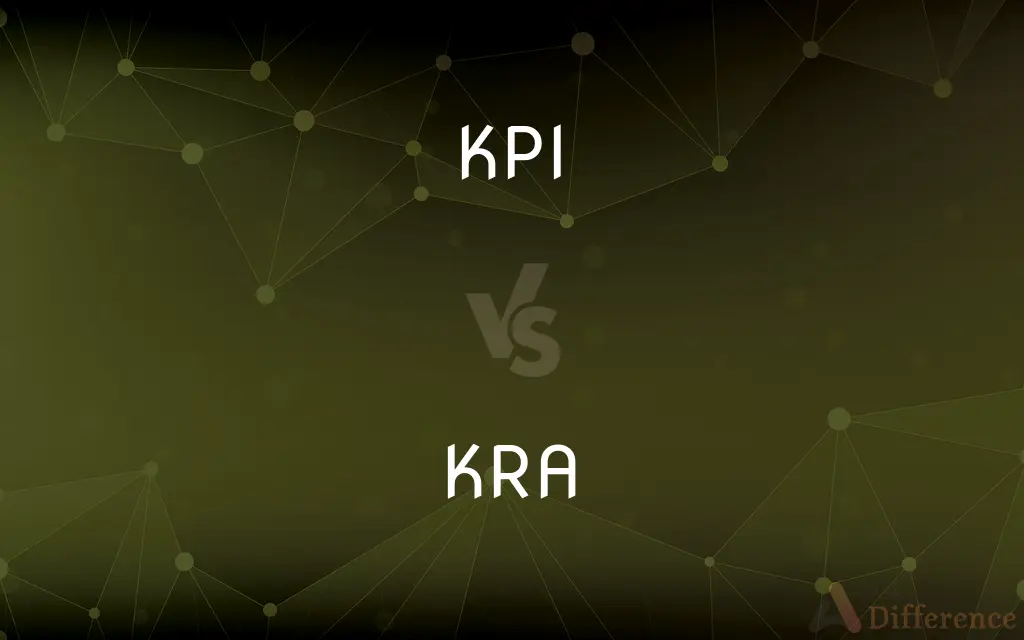KPI vs. KRA — What's the Difference?
By Tayyaba Rehman — Published on December 26, 2023
KPI (Key Performance Indicator) measures specific performance, while KRA (Key Result Area) defines critical areas of outcome.

Difference Between KPI and KRA
Table of Contents
ADVERTISEMENT
Key Differences
KPI, or Key Performance Indicator, is a quantifiable metric used by organizations to evaluate the success of a particular activity. It helps to provide a clear focus on performance. On the contrary, KRA, or Key Result Area, refers to the broader sectors or areas within an organization where outputs contribute to its business goals, essentially defining the scope of specific job roles.
KPIs are used to monitor the effectiveness of various processes in an organization. These indicators help in gauging the performance of strategies and activities. Conversely, KRAs are broader and provide a larger picture of what needs to be achieved within a certain department or role, setting the foundation for performance expectations.
KPIs are tangible and can be numerically measured. They provide data-driven feedback, assisting organizations in making informed decisions. In contrast, KRAs represent specific functional areas where achievements are essential for organizations to reach their goals, and while they can be linked to KPIs, they aren't always numeric.
While KPIs are essential for an organization's short-term goals and immediate actions, KRAs offer a long-term vision. KRAs identify areas critical for an organization's success, while KPIs monitor the steps towards achieving those outcomes.
It's important to understand that KPIs are a subset of KRAs. While KRAs determine the essential result areas, KPIs measure the success and performance within those areas. So, KPIs can be seen as the tools or metrics that monitor the progress of KRAs.
ADVERTISEMENT
Comparison Chart
Definition
Quantifiable metrics to gauge performance.
Broader sectors where outputs are essential for business success.
Focus
Specific performance of strategies and activities.
Areas critical to an organization's achievement.
Nature
Tangible and numeric.
Broad, encompassing key areas.
Purpose
Monitors the effectiveness of processes.
Sets the foundation for performance expectations.
Timeframe
Typically short-term goals and immediate actions.
Offers a long-term vision for the organization.
Compare with Definitions
KPI
A tool for assessing progress towards set goals.
The reduction in production costs is a KPI for the manufacturing department.
KRA
General areas setting performance expectations.
Customer retention is a KRA in the service industry.
KPI
Data-driven feedback for performance analysis.
The conversion rate is a KPI for online campaigns.
KRA
Broader sectors vital for organizational success.
Product development is a KRA for tech companies.
KPI
A metric used to evaluate the effectiveness of an activity.
Sales growth rate is a KPI for the marketing team.
KRA
Represents essential areas contributing to business goals.
Operational efficiency is a KRA for the production unit.
KPI
Specific indicators driving strategic decisions.
Net promoter score (NPS) is a KPI to evaluate brand loyalty.
KRA
Defines critical outcome areas for specific job roles.
Market expansion is a KRA for the sales team.
KPI
A quantifiable measure to gauge an organization's performance.
Customer satisfaction score is a KPI to determine service quality.
KRA
Provides the foundation for measurable objectives.
Brand awareness is a KRA for the marketing department.
KRA
A long-tailed ape (Macacus cynomolgus) of India and Sumatra. It is reddish olive, spotted with black, and has a black tail.
Common Curiosities
What's the relationship between KPI and KRA?
KRAs define critical areas of achievement, and KPIs measure the performance within those areas.
Which is broader, KPI or KRA?
KRA is broader, focusing on essential result areas, while KPIs are specific metrics within those areas.
How frequently should KPIs be reviewed?
The frequency of reviewing KPIs varies, but it's often done regularly to monitor ongoing performance.
Is KRA long-term or short-term focused?
KRAs generally offer a long-term vision for an organization, defining areas critical for success.
Are KPIs always numeric?
KPIs are quantifiable and are generally numeric, providing tangible data on performance.
Can a KPI be a part of a KRA?
Yes, KPIs are often subsets of KRAs, measuring success within those defined areas.
Can there be multiple KPIs for one KRA?
Yes, a single KRA can have multiple KPIs to measure various aspects of performance within that area.
What does KPI stand for?
KPI stands for Key Performance Indicator.
How do organizations choose their KPIs?
KPIs are chosen based on their relevance to organizational goals, strategic priorities, and the specific outcomes they can measure.
What is the main function of a KRA?
KRA (Key Result Area) defines critical areas of outcome essential for an organization's success.
Why are KPIs important for businesses?
KPIs help businesses assess their performance, make data-driven decisions, and achieve set goals.
Is KRA linked to job roles?
Yes, KRAs often define the critical areas of outcome related to specific job roles.
Who typically defines the KRAs in an organization?
KRAs are usually defined by senior management or leadership to align with organizational goals.
Can KRAs change over time?
Yes, KRAs can evolve as organizational goals and strategies change.
Are KPIs industry-specific?
While some KPIs are industry-specific, many can be applied across various sectors.
Share Your Discovery

Previous Comparison
Primary Metabolites vs. Secondary Metabolites
Next Comparison
Aluminum Foil vs. Tin FoilAuthor Spotlight
Written by
Tayyaba RehmanTayyaba Rehman is a distinguished writer, currently serving as a primary contributor to askdifference.com. As a researcher in semantics and etymology, Tayyaba's passion for the complexity of languages and their distinctions has found a perfect home on the platform. Tayyaba delves into the intricacies of language, distinguishing between commonly confused words and phrases, thereby providing clarity for readers worldwide.














































